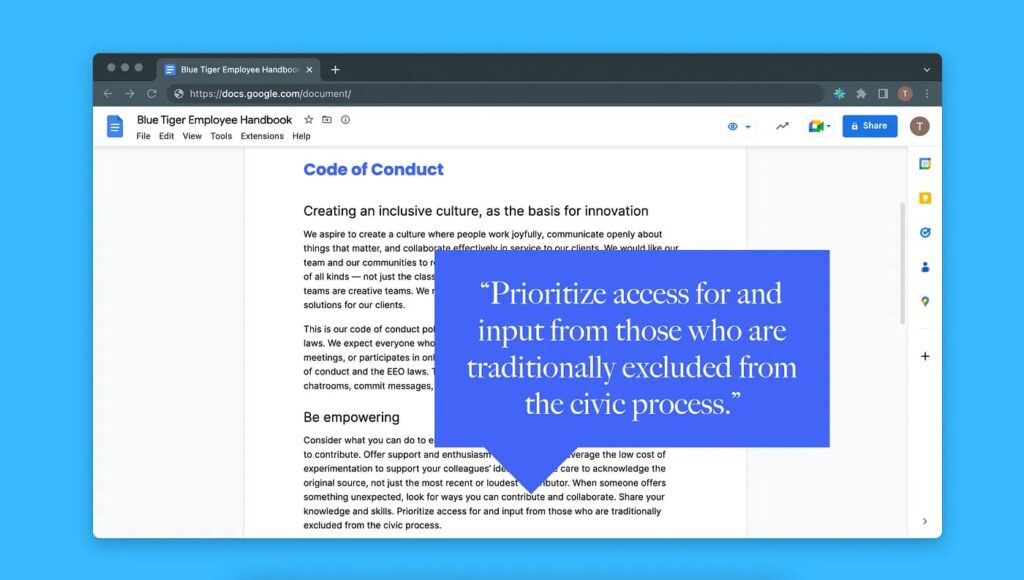Prioritizing those traditionally excluded from the civic process
By: Tyler Gindraux
November 30, 2022 | Civic Technology, Design, Inclusion, Service Design, User Research
Insights
I’m Tyler. I recently joined Blue Tiger as a Senior UX Researcher.
During onboarding last month, I sat down to read our employee handbook. Besides help booking a day off or claiming an expense, our handbook also includes a code of conduct. This describes the type of environment we aim to create and maintain at work.
Our code of conduct encourages certain behaviors, like, “creating boundaries and safe spaces.” And discourages others, like, “assuming our way of thinking or behaving is the norm, particularly if we’re in a position of power or privilege.”
Many other organizations inspired Blue Tiger’s code of conduct. It clarifies our shared values and shapes how we show up to work everyday.
This post is about one sentence in our code of conduct, inspired by Code for America’s:
“Prioritize access for and input from those who are traditionally excluded from the civic process.”

In this post, I’ll describe what this means to me — and how I plan to do this as a researcher and designer in civic technology.
The civic process must be open to all
First, what is the civic process? The civic process includes things people do to take part in their local or federal area.
For example, vote in an election, ask a question of a local representative, or attend a community meeting.
In an Executive Order in 2022, President Biden says:
“Government must be held accountable for designing and delivering services with a focus on the actual experience of the people whom it is meant to serve.”
And, as Cyd Harrell, Chief Digital Services Officer for the City of San Francisco, says, in A Civic Technologist’s Practice Guide:
“One of the most interesting aspects of technology in the civic context is the hard constraint that the product you build must serve everyone.”
But, while our civic process must be open to everyone, being open by law doesn’t mean that it’s inclusive.
Some people have been excluded
Those traditionally excluded from civics often disproportionately includes people from marginalized groups, or people who face inequities based on race, class, gender or other factors (Source).
People are excluded from the civic process in different ways. For example, someone might not be able to fill out a survey that isn’t available in their native language, as Lexie Pèrez-Grüber writes.
Another form of exclusion is when a website fails to meet accessibility standards. In a 2021 report, ITIF found that 48% of popular federal websites fail to meet WCAG 2.0 Level AA guidelines on at least 1 of their 3 most visited pages.
And exclusion results in different levels of engagement. In mySociety’s review of selected civic websites, they find that not one website’s user base has an ethnicity breakdown that matches the respective population.
Whether by design or not, exclusion from civics is a reality for many.
Doing what’s necessary
In A Civic Technologist’s Practice Guide, Harrell describes two types of civic work: doing what’s necessary and showing what’s possible. I find this is a helpful way of thinking about next steps.
As a civic researcher and designer, doing what’s necessary can include:
- recruiting a research sample that reflects the diversity of the population, for example, by using maximum variation sampling
- writing demographic questions that account for intersectional identities
- using different channels to recruit people who I haven’t reached in the past
- understanding power in design, starting with George Aye’s critique on design education
- planning research engagements that support everyone to take part fully
- looking at my biases and learning from those who challenge and expand my views, like, Leah Lakshmi Piepzna-Samarasinha on disability justice, Sarah Fathallah on trauma-responsiveness and Vivianne Castillo on ethics and power.
These are steps I have and will continue to take to focus on inclusion.
Showing what’s possible
And then there’s showing what’s possible. By, “showing what’s possible,” I think Harrell describes the ways we push practices forward. Beyond doing what’s necessary, she’s asking us to show and test alternative approaches.
As a civic researcher and designer, showing what’s possible can include:
- hiring peer researchers or people with lived experience, as I’ve learned from in this Aboriginal and Torres Strait Islander community-led research initiative
- proposing and following a co-design approach through a program of work
- using relational ethics to encourage accountability in research, like Alba Villamil highlights in her review of Feminist Methodologies
- creating policies and practices to borrow from across programs of work
- writing about mistakes and successes so that we learn from them.
It’s my hope that approaches like these help expand how I focus on input from those who are often excluded.
And through showing what’s possible alongside doing what’s necessary, we design more equitable civic services.
Thanks for reading. I’d love to hear from you: tyler@bluetiger.digital
